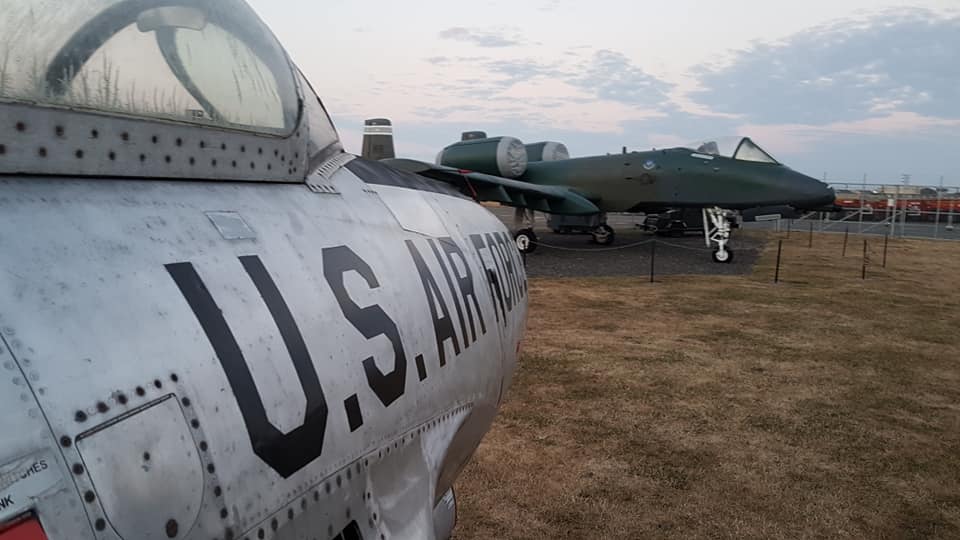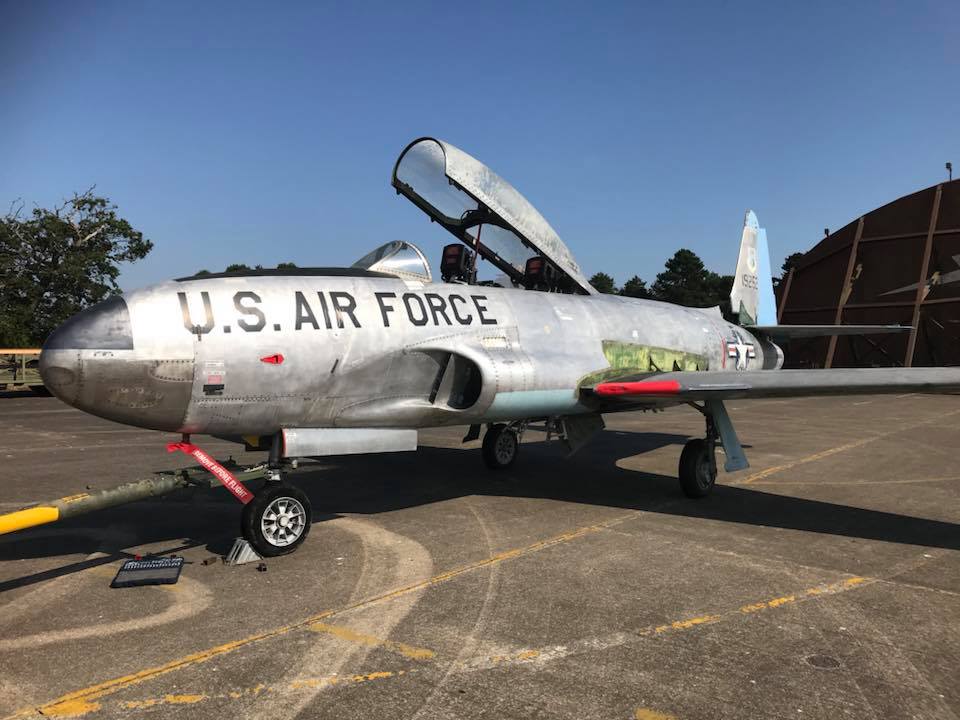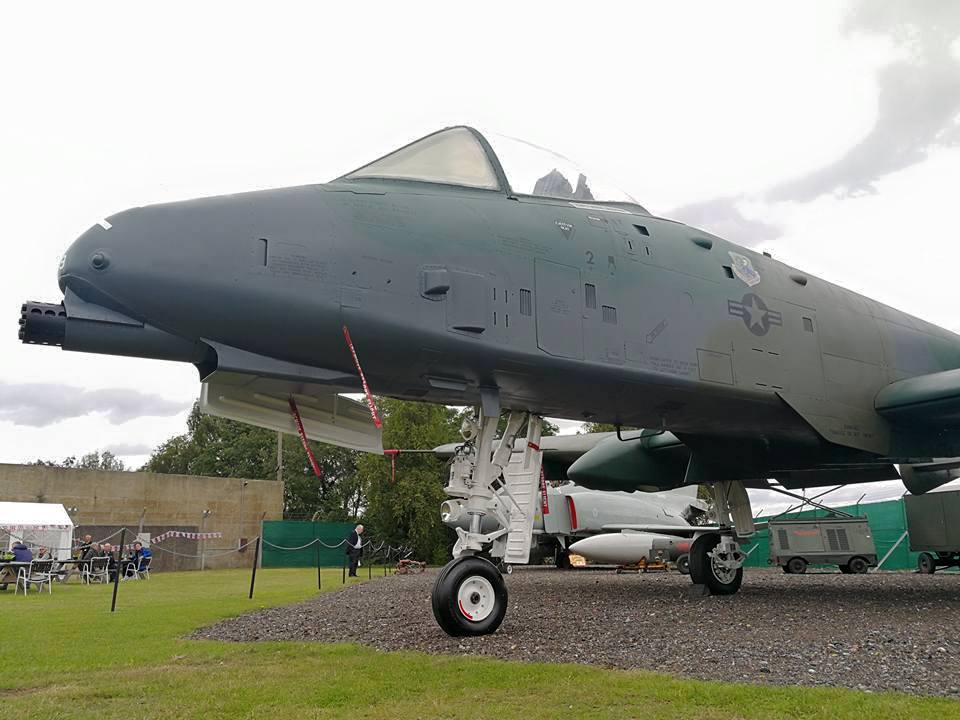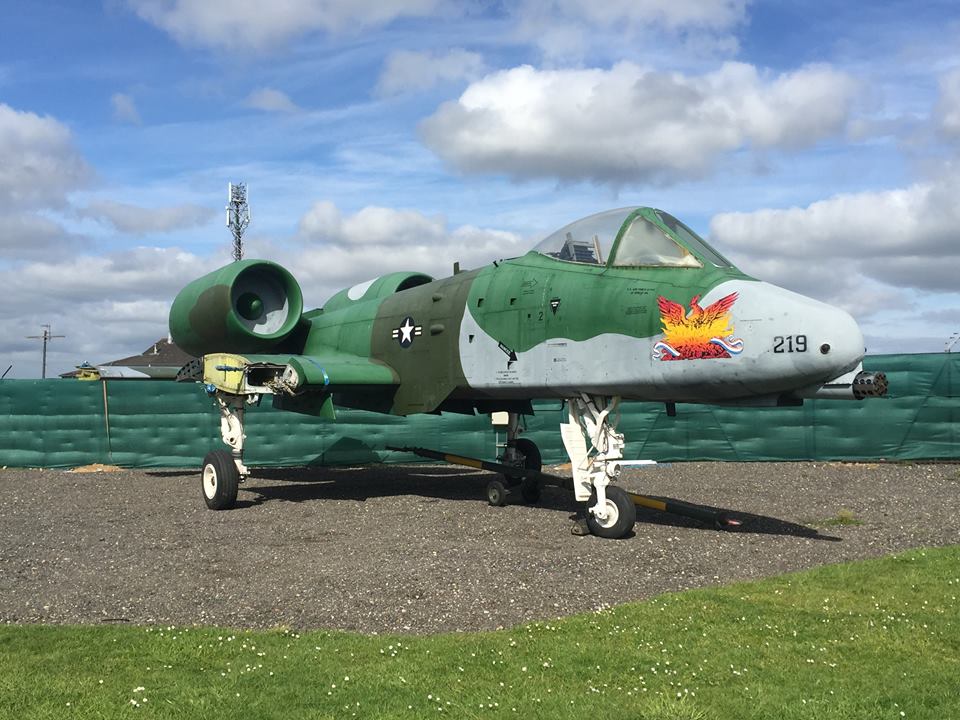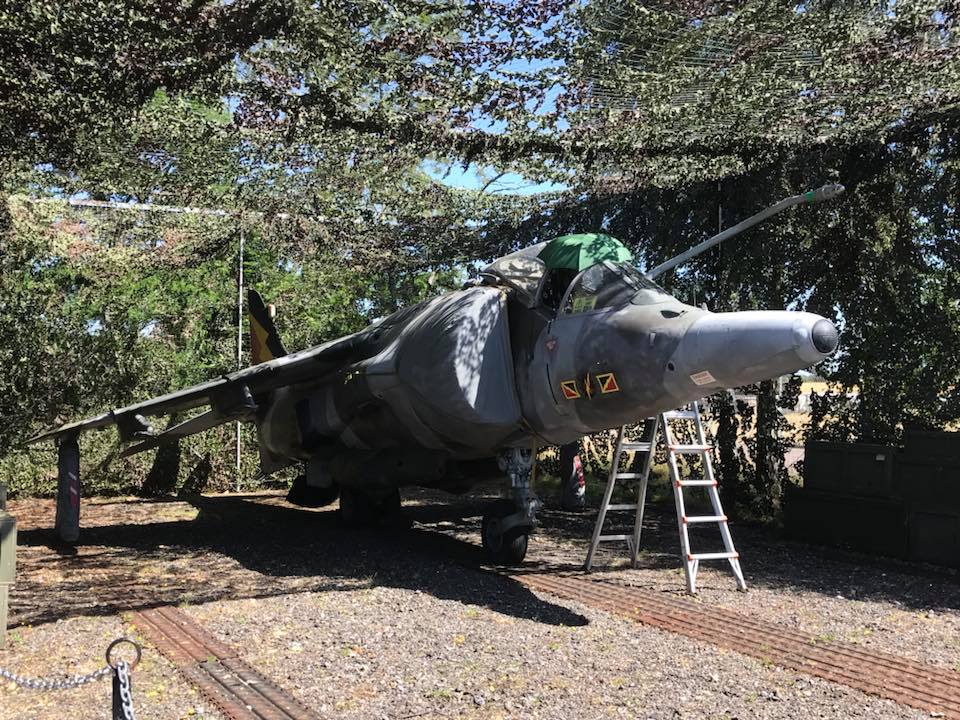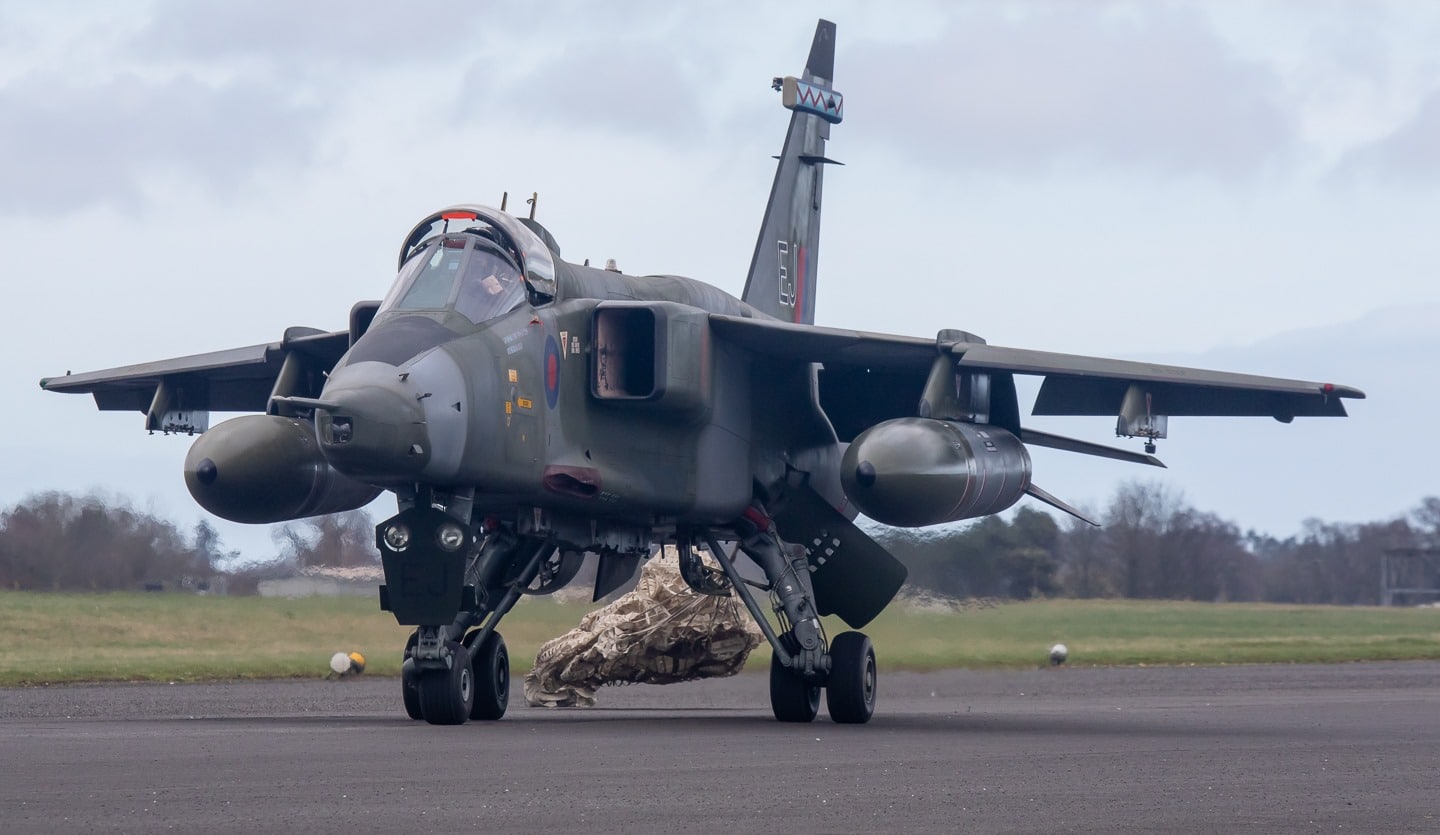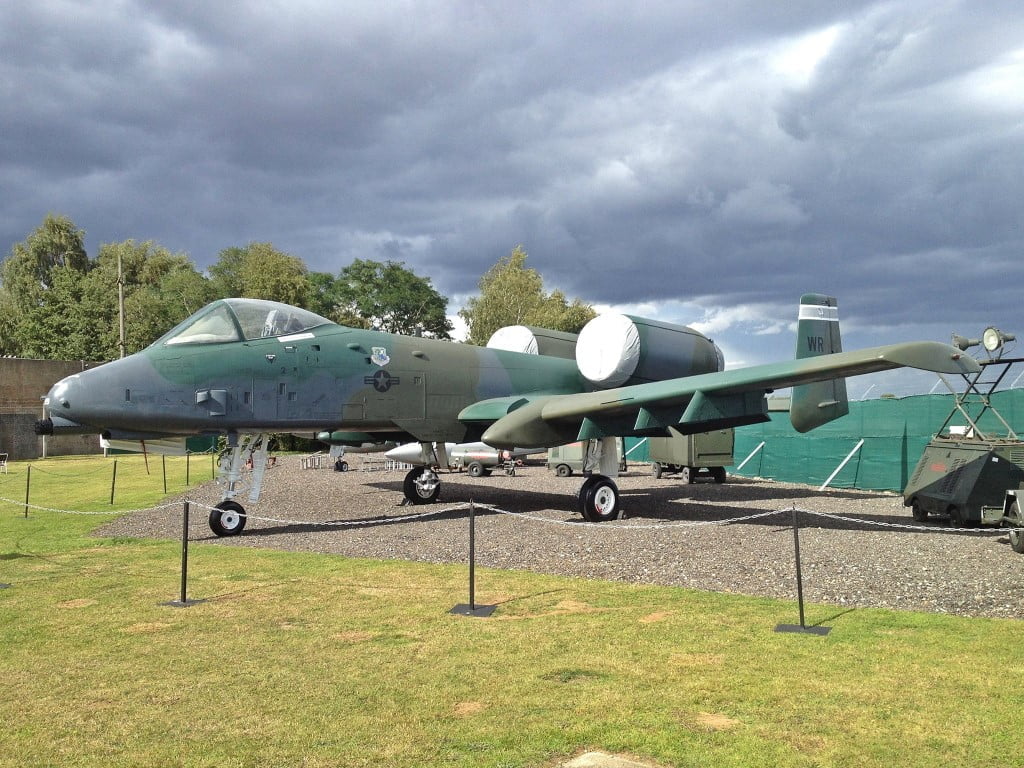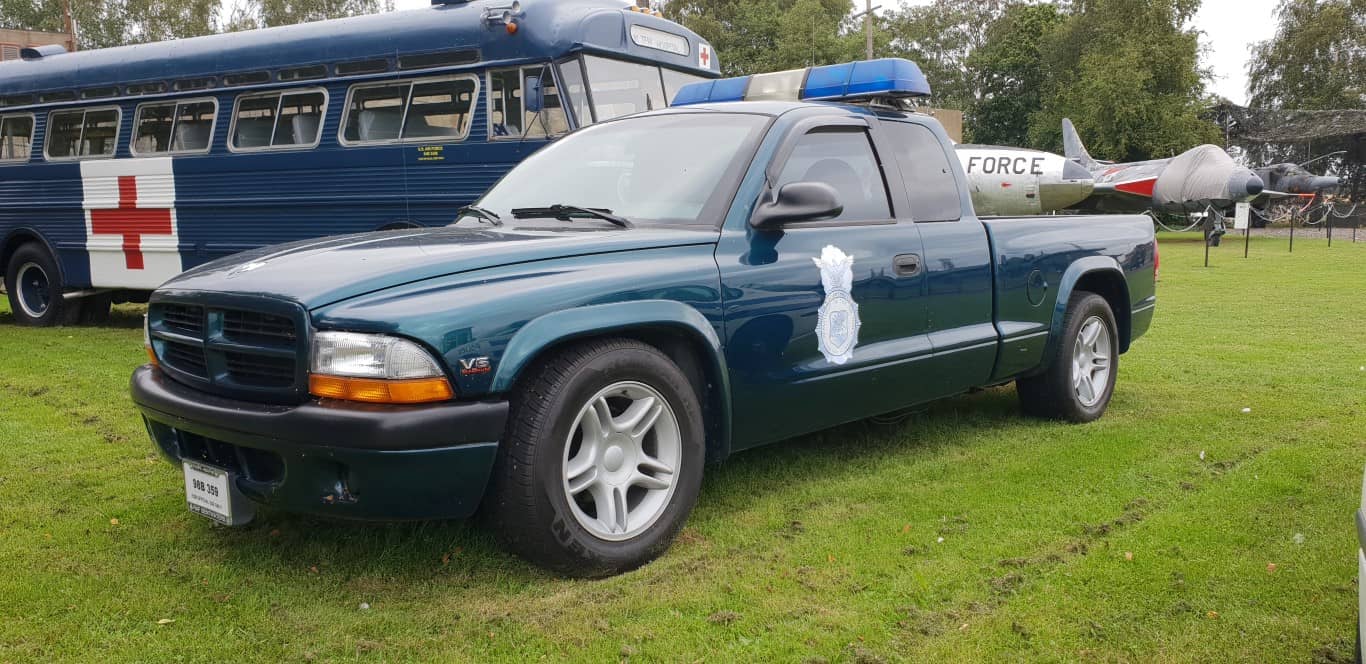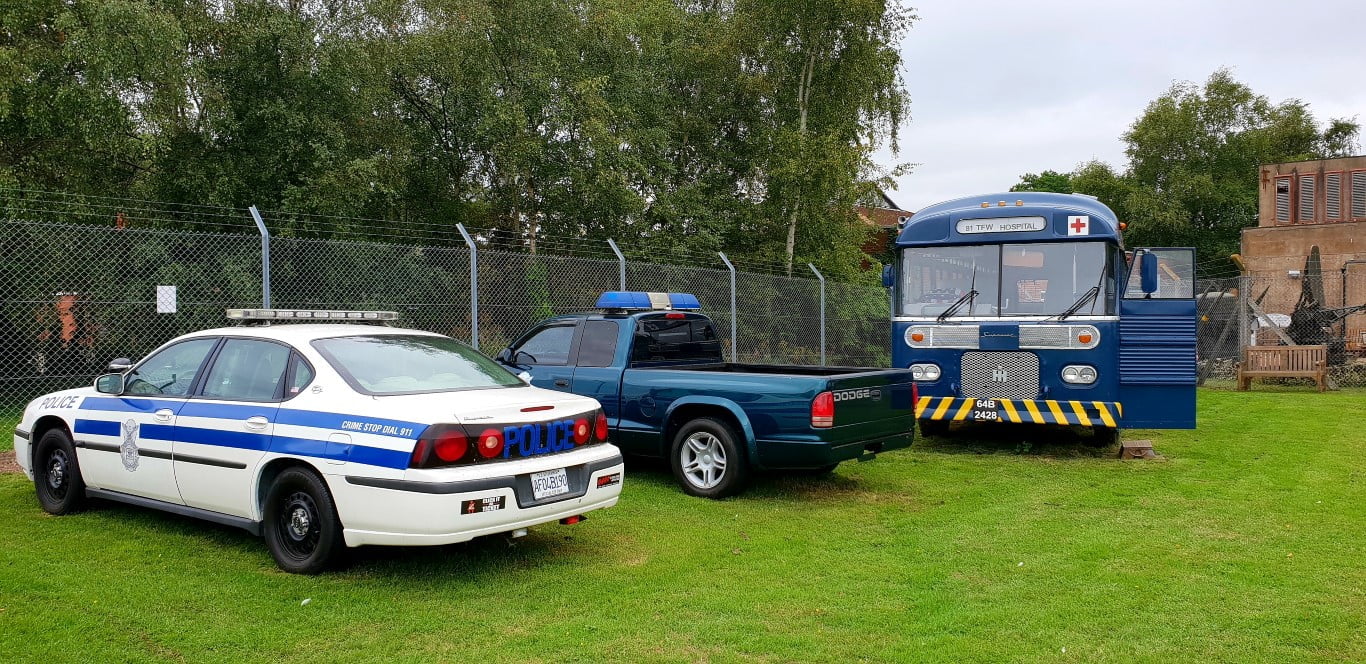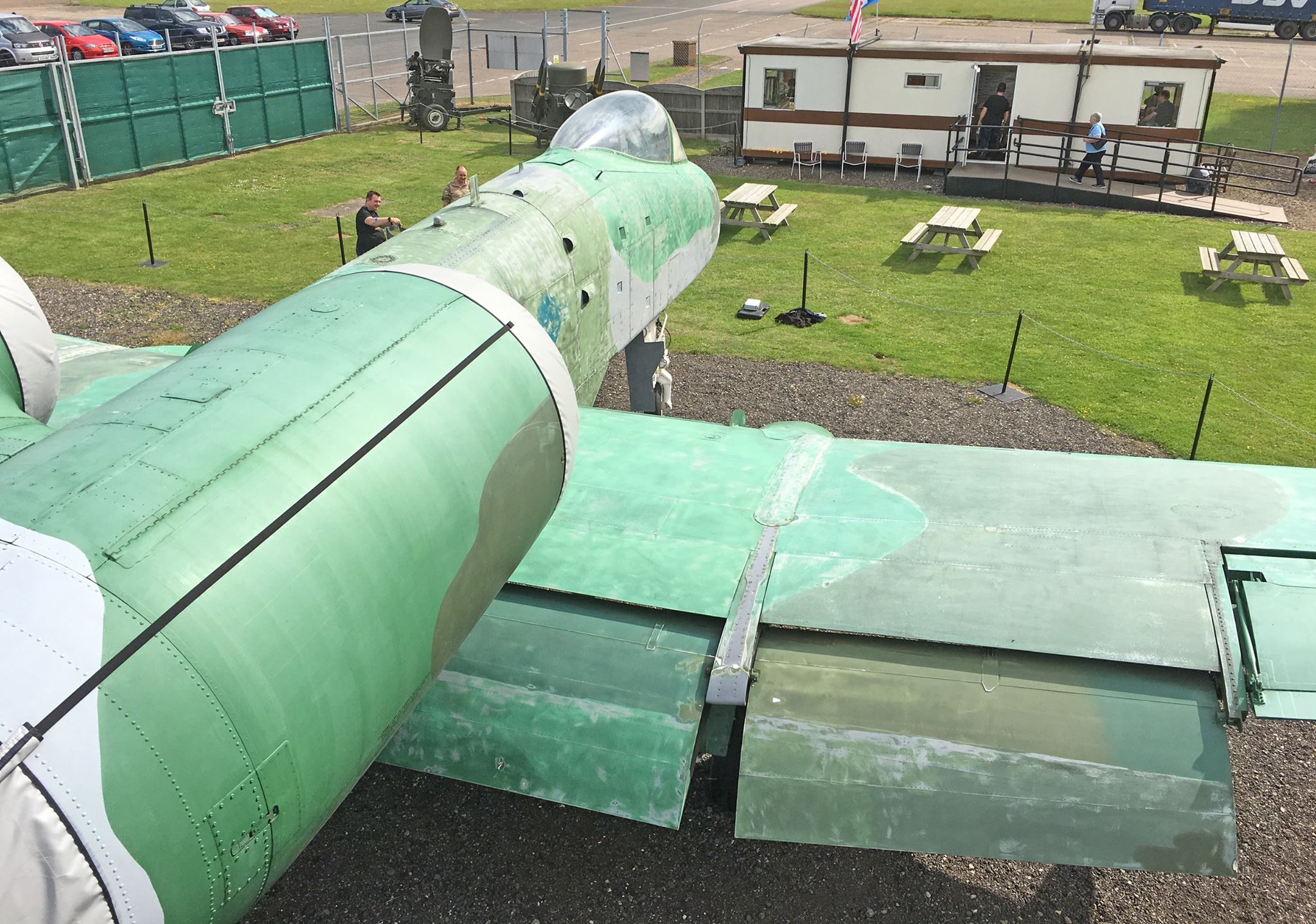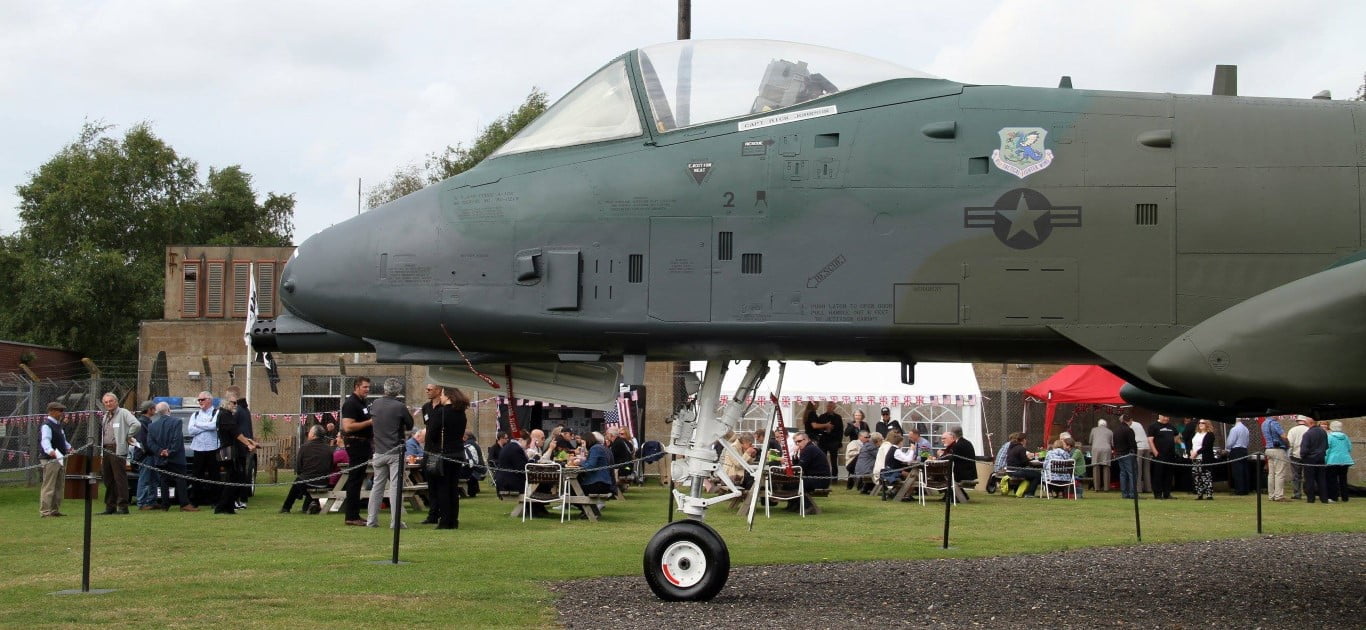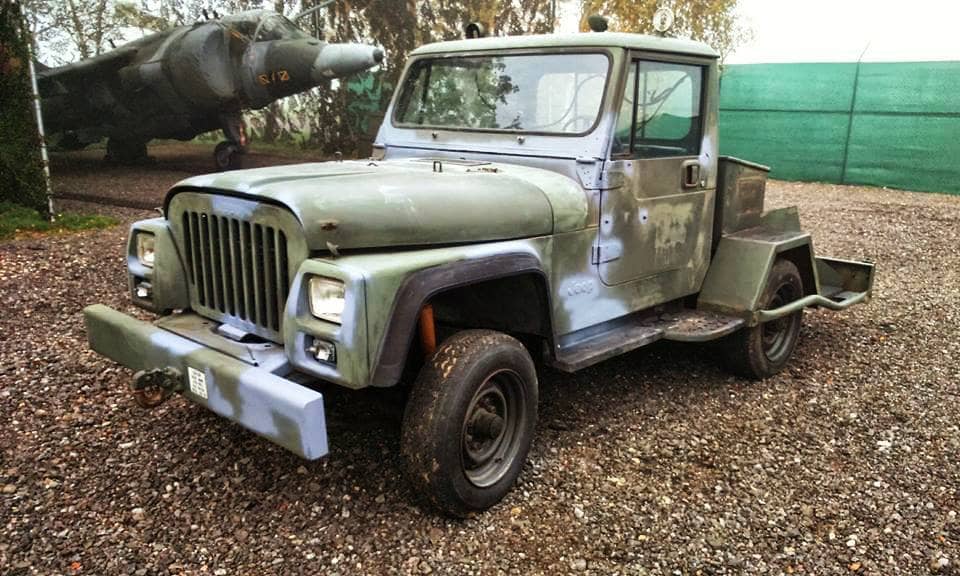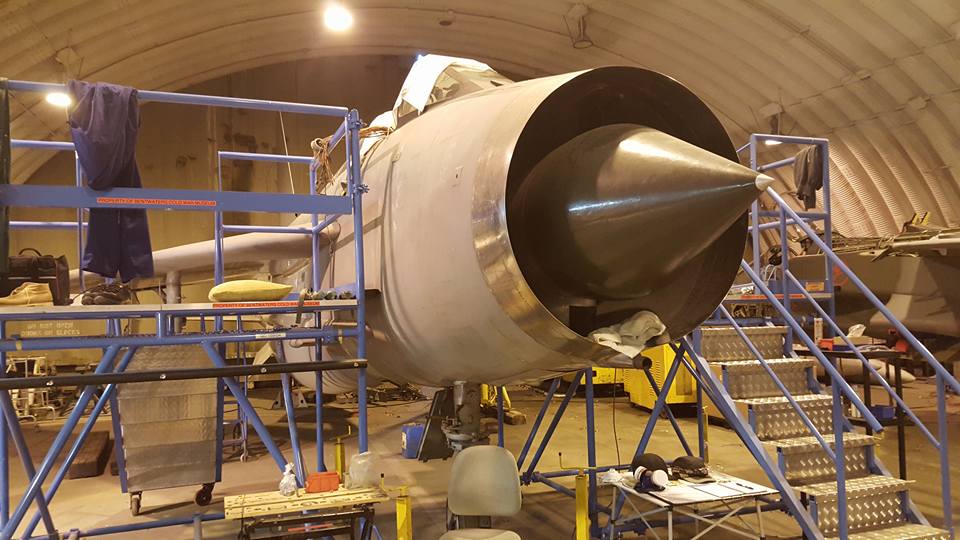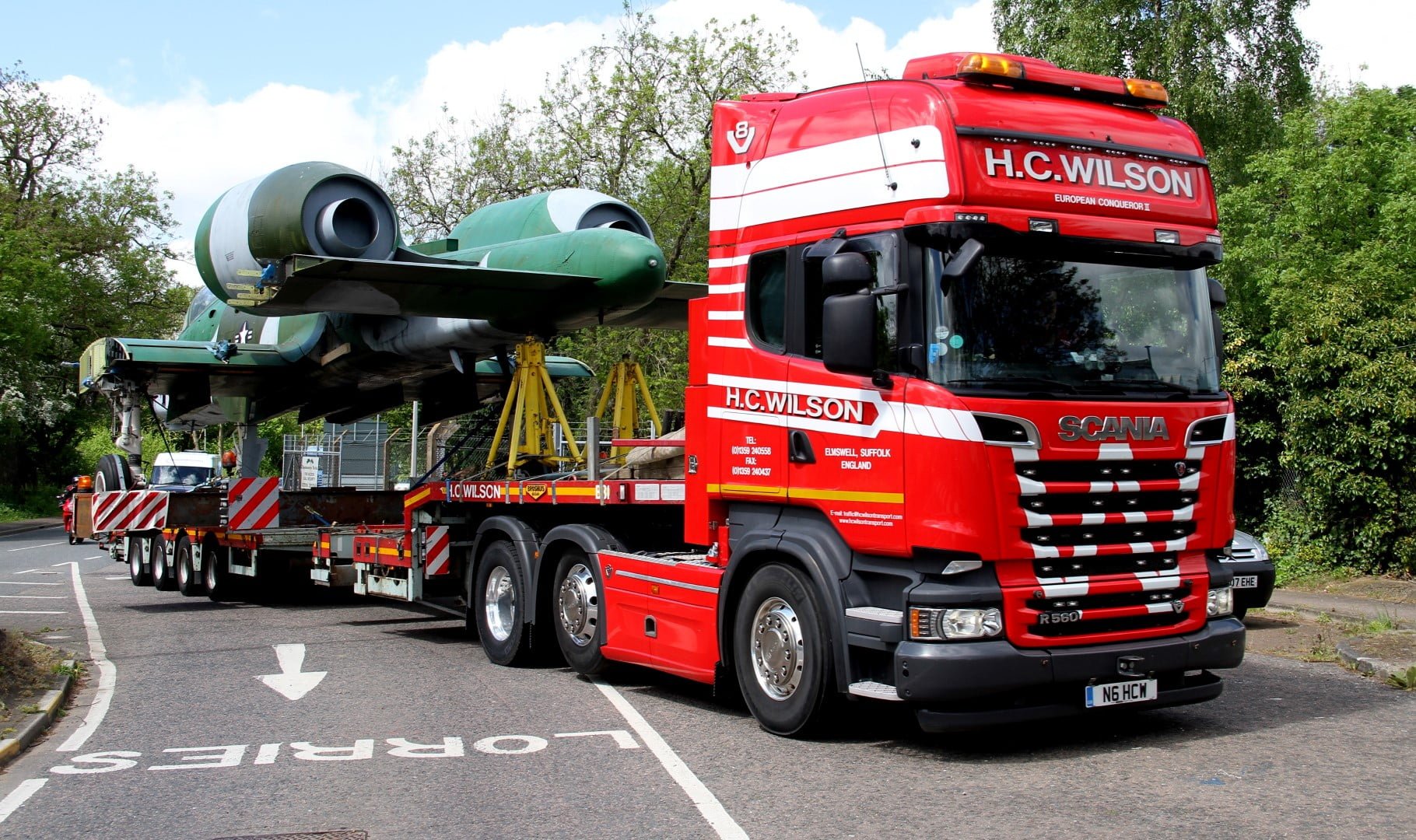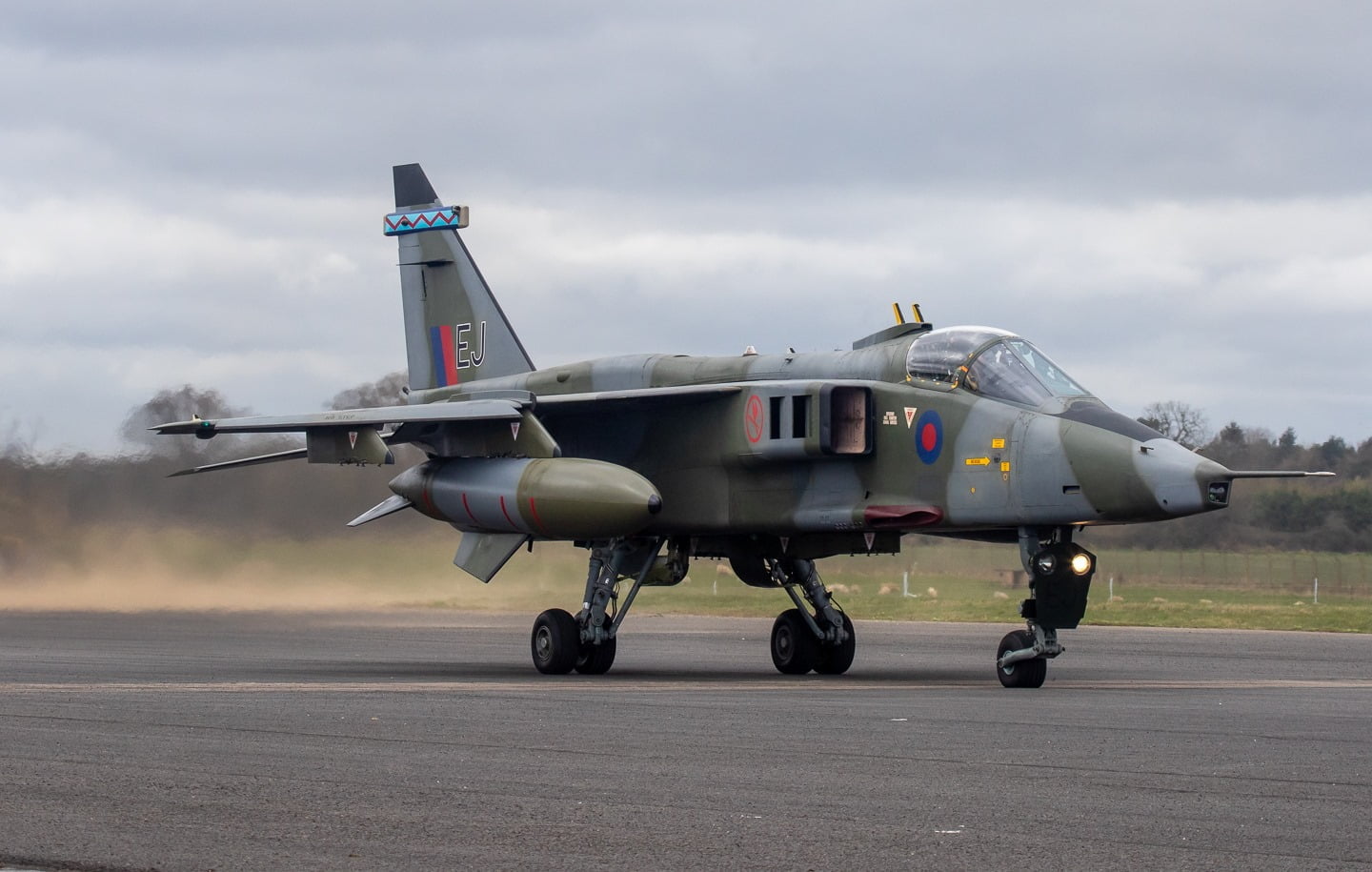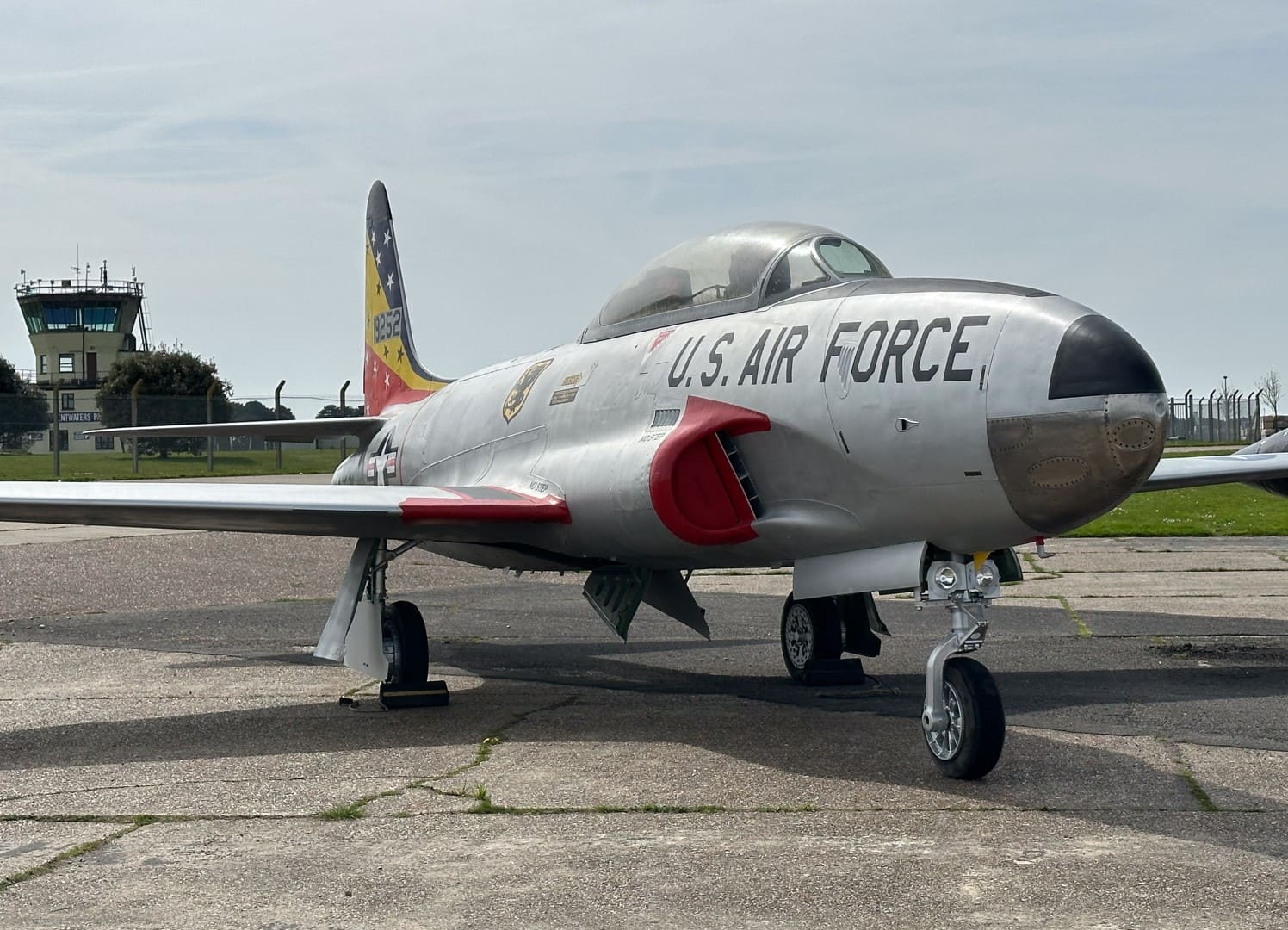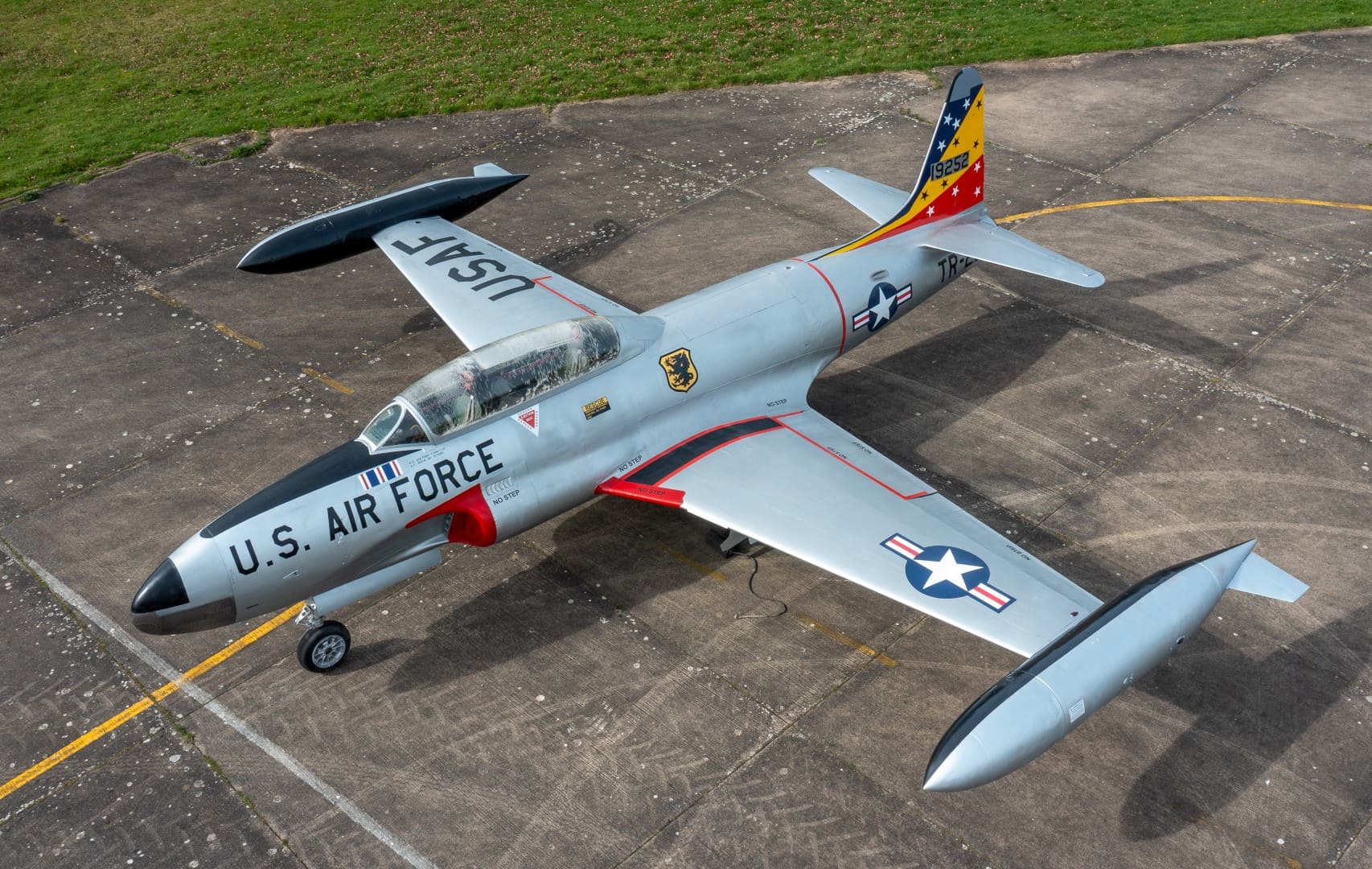AIRCRAFT & VEHICLES
The museum has a growing collection of aircraft representing the “Cold War” era. The museum’s first acquisition was a Meteor D.16. which was purchased in 2005. It has been the subject of a very lengthy restoration and a conversion back to its original F.8 configuration. When complete it will have working electrics and hydraulics and will wear the markings of No. 72 Sqn.
During October 2009 a Sepecat Jaguar joined the museum collection, and following completion of many years of restoration, it has now been returned to ground-running condition., and is the only privately owned taxiiable Jaguar in the world. On July 1st 2010, Hawker Hunter XE707, also joined the museum collection. May 2011 saw the arrival of our English Electric Lighting. This is currently undergoing a full restoration. Subsequent purchases have included a Harrier GR.3 and Phantom FGR.2.
In 2016, the museum received a Fairchild A-10A aircraft on loan from the USAF that was an ex Bentwaters 509th TFS airframe. This was restored and repainted throughout 2017 and is now on display within the museum compound.
In 2018 we took delivery of a T-33A Shooting Star airframe that was finished in restoration terms in April 2024, and is now on public display. Also under restoration but on public display is Hawker Hunter XE707.
The latest addition to the museum’s aircraft collection is a Republic F-84F Thunderstreak which will be undergoing restoration and arrived in October 2019.
Visits to see the aircraft not on public display, but under restoration are possible via the BCWM Restoration Hangar Tours, and on group visits if requested.
The museum also has an ever increasing fleet of vehicles and utility accessories that include an International Harvester Hospital Bus, an ex USAF Dodge Dakota pickup, a Coleman MB4 tractor, a USAF flight line tractor, a Rapier missile unit, USAF “Lite All” units, a USAF Tool Trolley, and an aircraft oxygen cart.
Please note that aircraft under restoration are only viewable by the public on BCWM Restoration Hangar tours.
Can you help? We are always looking for information on any of the museum aircraft, do you have any photos, manuals, or spare parts etc? If so we would be very pleased to hear from you. Please use the contact page to get in touch with us.
AIRCRAFT
BAe HARRIER GR.3 – ON DISPLAY
ZD667 was the first of a batch of four Harrier GR.3s built for the RAF as a stop-gap whilst the second generation Harrier (GR.5 later converted to GR.7 and GR.9 variants), was entering service in the late-80s. As a consequence of this, ZD667 was actually a newer aircraft than several of the Harrier GR.9s that were in service with the RAF up until December 2010. ZD667 only spent eight years in frontline service with the RAF before being retired.
Following retirement ZD667 was transferred to the Royal Navy at RNAS Culdrose where it was used for training Fleet Air Arm groundcrew in the art of handling aircraft on carrier decks. With the loss of the Fleet Air Arm’s fixed wing component (due to the retirement of the Sea Harrier), there was no longer a requirement for fixed wing deck handling training. During May 2007, ZD667 was moved to Culdrose’s satellite airfield at RNAS Predannack where it was used for fire and crash rescue training.
ZD667 was purchased by Everett Aero in December 2012 and subsequently bought by the Museum in February 2013 following a generous donation by Bentwaters Aviation Society member, Brian Smee. ZD667 has been re-painted in the very colourful markings it wore whilst assigned to IV(AC) Sqn at RAF Gütersloh in West Germany during the late-1980s.
TECHNICAL SPECS
Manufacturer: BAe
Purpose: Single-seat fighter bomber
Crew: One
Wingspan: 25 ft 3″
Length: 45 ft 5 “
Height: 11 ft 3 “
Weight (Empty): 12,300 lb / 5,579 kg
Service ceiling: 55,000 ft / 16,764 metres
Engines: 1x Rolls-Royce Pegasus 11 Mk.103
Performance: 746 mph / 1,200 km/h
WEAPONS
Guns: 2× 30 mm (1.18 in) ADEN cannon pods under the fuselage (we have these fitted to ZD667)
Hardpoints: 4× under-wing & 1× under-fuselage pylon stations with a capacity of 5,000 lb (2,268 kg) and provisions to carry combinations of:
Rockets: 4× Matra rocket pods with 18× SNEB 68 mm rockets each
Missiles: 2× AIM-9 Sidewinders Air-to-air missiles
Bombs: A variety of unguided iron bombs, BL755 cluster bombs or laser-guided bombs
Others: 1× Reconnaissance pod / 2× drop tanks for extended range/loitering time
HISTORY
Construction no. – 712228
Place of manufacture – BAe’s Kingston factory
Date of manufacture – Early 1986
First Flight – 26th September 1986
Date delivered – 5th November 1986
ASSIGNMENTS
14/11/86 to 1990 – Coded U No. 4 Sqn Gütersloh
1992 – Coded 3F No. 233 OCU Wittering
1993 – Coded 3B 1417 Flt Belize
1994 – Coded 3B SAH Culdrose
1999 – Coded 3,2 SFDO Culdrose
May 2007 – Predannack Fire School
08/12/2012 – Everett Aero at Bentwaters
02/2013 – Bentwaters Cold War Museum
Total flying hours – To be confirmed
Date received by the museum – February 2013
ENGLISH ELECTRIC LIGHTNING F.53 – UNDER RESTORATION – Can be viewed on optional HAS tour.
Built for the Royal Saudi Air Force with serial number 53-675 and first flown by Roland Beamont on 19th December 1967 from Salmesbury, the aircraft was delivered to Jeddah on 16th September 1968 by Flt Lt Anders. From Jeddah, 53-675 transferred to 2 Sqn at Riyadh for two years whilst the Saudis worked up on the type. After serving at other bases such as Dhahran, Camis and Al Salem, still with 2 Sqn, 675 was retired by the Saudis on the 1st January 1986.
Purchased back by British Aerospace for a possible deal with the Austrian Air Force and given the new serial number of ZF581, she was flown back to Warton on 14th January 1986 having made over 2100 flights with just over 2000 hours. With the Austrian deal a non-starter, ZF581, along with a number of other ex-Saudi Lightnings, were sold to Wensley Haydon-Bailey and shipped to Southampton docks for container storage. The batch of Lightnings was sold again in 1997 and moved to Marine Salvage in Portsmouth.
ZF581 was the last Lightning to be sold by Marine Salvage, being purchased (again) by British Aerospace in early 2001. ZF581 was restored by the company and placed on display outside its Rochester factory in 2004.
TECHNICAL SPECS
Manufacturer: English Electric
Purpose: Single-seat fighter
Crew: One
Wingspan: 34 ft 10″ / 10.6 metres
Length: 55 ft 3 ” / 16.8 metres
Height: 19 ft 7 ” / 5.97 metres
Weight (Empty): 31,068 lb / 14,092 kg
Service ceiling: 54,000 ft / 16,000 metres / zoom ceiling >70,000 ft
Engines: 2 × Rolls-Royce Avon 301R
Performance: Mach 2.0 /1,300 mph / 2,100 km/h at 36,000 ft
WEAPONS
2× 30 mm (1.18 in) ADEN cannons,
2× under-fuselage for mounting air-to-air missiles,
2x overwing pylon stations for 260 gal ferry tanks and provisions to carry combinations of either 2 De Havilland Firestreak or 2× Hawker Siddeley Red Top missiles
ZF581 HISTORY
Construction no. – 95280
Place of manufacture – Warton
Date of Manufacture -19th December 1967
Type – F53 53-675
Date of delivery to RSAF – 16th September 1968
ASSIGNMENTS
16th September 1968 Royal Saudi Air Force
14th January 1986 BAe Warton
Total flying hours – 2304
Date received by the museum – May 2011
FAIRCHILD A-10A – ON DISPLAY
80-0219 was constructed during early 1981 at the Fairchild Republic Maryland factory and delivered to the 81st TFW at RAF Bentwaters on the 14thDecember 1981 and assigned to the 509th Tactical Fighter Squadron. 80-0219 moved with the 509th TFS to nearby RAF Alconbury in May 1988, now under control of the 10th TFW.
On the 4th April 1989 80-0219 crashed at RAF Alconbury, following a technical problem the aircraft overran the runway and crashed into the field beyond, the pilot ejecting safely. After some cosmetic repairs the airframe was placed on display within RAF Alconbury now designated as a GA-10A.
Following a long held ambition to display an A-10 at the museum, this became a possibility during 2015, with the museum signing a loan agreement with the National Museum of the US Airforce in February 2016, and following the work to dismantle the airframe for transport it arrived at the museum on 24th May 2016. Upon arrival at the museum, some anti-corrosion work was carried out and the aircraft reassembled and painted into the correct Euro one colour scheme in 81st TFW/509th TFS markings.
Technical Specs
Manufacturer: Fairchild Republic Co.
Purpose: Close Air Support
Crew: One
Wingspan: 57’6” / 17.42 Meters
Length: 53’4” / 16.26 Meters
Height: 14’8” / 4.47 Meters
Weight (Empty): 24,959 lb. / 11,321 Kg
Service Ceiling: 45,000 feet / 13,700 Meters
Engines: 2x General Electric TF34-GE-100 Turbofans
Performance: Maximum speed 439 mph /706 km/h at sea level clean, combat radius 280 miles / 460 km with loiter time, ferry range 2580 miles, 4150 Km.
Weapons
Guns: 1x 30mm GAU-8 seven barrel Gatling gun
Hardpoints: Up to 16,000 pounds (7,200 kilograms) of mixed ordnance on eight under-wing and three under-fuselage pylon stations, including 500 pound (225 Kg Mk-82 and 2,000 pound (900 Kg) Mk-84 series low/high drag bombs, incendiary cluster bombs, combined effects munitions, mine dispensing munitions, AGM-65 Maverick missiles and laser-guided/electro-optically guided bombs; infrared countermeasure flares; electronic countermeasure chaff; jammer pods; 2.75-inch (7 Cm) rockets; illumination flares and AIM-9 Sidewinder missiles.
History
Construction no. – A-10-0569
Place of Manufacture: Hagerstown, Maryland, USA
Date of Manufacture: Early 1981
First Flight: To Be Confirmed
Date Delivered: To Be Confirmed
Assignments
14th December 1981 arrives at RAF Bentwaters, Suffolk, UK and assigned to 509th Tactical Fighter Squadron.
June 1988 moved with the 509th Tactical Fighter Squadron to RAF Alconbury, Cambridgeshire, UK
4th April 1989 accident at RAF Alconbury, overshot the runway during attempted touch & go and crashed, pilot ejected safely.
24th May 2016 – Arrives at the Bentwaters Cold War Museum (on loan from NMUSAF since 11th February 2016)
Total Flying Hours – To Be Confirmed
Date Received by the museum – May 2016
GLOSTER METEOR F.8 – UNDER RESTORATION – Can be viewed on optional HAS tour.
WH453 arrived at the museum in January 2005 having arrived from Llanbedr in Wales, where it had previously been in use as a static engine test frame after retiring from flying in 1990. The aircraft started life as an F.8 fighter version serving with RAF 222sqn, 72Sqn and then 5 CAACU.
In 1972 it was one of several Meteor airframes selected to be converted to a U.16 drone, which meant it could be flown by remote control from the ground whilst towing a target banner for aircraft to practice shooting at. The aircraft is currently undergoing a long term full restoration back to a F.8 fighter version and will be painted in the colours of 72 Sqn when complete.
TECHNICAL SPECS
Manufacturer: Gloster Aircraft Company
Purpose: Single seat day fighter
Crew: One
Wingspan: 37 ft 2” / 11.8 metres
Length: 44 ft 7” / 13.5 metres
Height: 13 ft / 3.9 metres
Weight (Empty): 10,684 lb. / 4,846 kg
Service ceiling: 43,000 ft / 13,106 metres
Engines: 2x Rolls Royce Derwent 8
Performance: 598mph at 10,000 ft
WEAPONS
4x 20mm Hispano cannons
HISTORY
Construction no. – G5/415582
Place of manufacture – built by Gloster aircraft company at Huccelcote
Date of Manufacture – work completed 12th October 1951
Type – built as an F.8, converted to U.16/D.16
Date of delivery to RAF – 19th October 1951
ASSIGNMENTS
19th October 1951 33MU (Maintenance unit)
11th March 1952 delivered to 222 Sqn at RAF Leuchars
9th May 1954 to Avro factory at Langar for maintenance
30th May 1954 delivered to 72Sqn at RAF Church Fenton
1st May 1956 delivered to 5 CAACU
13th October 1971 to 5 MU
18th April 1972 to MOD for U.16 drone conversion
9th April 1974 to Flight Refuelling for drone equipment installation
9th August 1974 to RAE West Freugh
6th January 1975 to RAE Llanbedr
13th September 1976 to Flight refueling for upgrades
24th November 1976 to RAE Llanbedr
10th October 1990 removed from flying at Llanbedr and used as static engine test frame
Total flying hours – 4106.55
Date received by the museum – 18th January 2005
HAWKER HUNTER GA.11 – ON DISPLAY
A very generous donation from Bentwaters Aviation Society member Brian Smee allowed the Museum to add another important Cold War jet to its growing collection – Hawker Hunter GA.11, XE707, which arrived at Bentwaters on 1st July following a long journey from Ashbourne in Derbyshire.
As the aircraft was airworthy prior to it being dismantling, there was only minimal restoration work required, just some minor anti-c0rrosion treatment and reassembly. XE707 has been repainted into an authentic Fleet Air Arm scheme as conversion back to an RAF F.4 variant would involve some substantial modifications.
Our thanks go to Chris Dovey and his team at Capel Plant Holdings Ltd. for their skill and expertise in the transportation of XE707 from Ashbourne to Bentwaters.
TECHNICAL SPECS
Manufacturer: Hawker Aircraft Limited
Purpose: Single seat fighter / fighter-bomber / reconnaissance
Crew: One
Wingspan: 33 ft 8 ” /10.26 metres
Length: 45 ft 11 ” /14.00 metres
Height: 13 ft 2 ” /4.01 metres
Weight (Empty): 14,122 lb / 6,405 kg
Service ceiling: 43,000 ft / 13,106 metres
Engines: 1 × Rolls-Royce Avon 207 turbojet
Performance: Mach 0.94 /715 mph at sea level
WEAPONS
4× 30 mm ADEN cannons, 4 underwing hardpoints with a capacity of 7,400 lb / 3,400 kg
HISTORY
Construction no. – HABL/003098
Place of manufacture – built by Hawker Aircraft Limited in Blackpool
Date of Manufacture – September 1955
Type – built as Mk4 variant
Date of delivery to RAF – 1st September 1955
ASSIGNMENTS
1st September 1955 5MU (Maintenance Unit)
93(F) Sqdn at RAF Jever, West Germany
118(F) Sqdn at RAF Jever, West Germany
1960 Stored in the UK
January 1961 moved to Arbroath with the Royal Navy
1962 converted to GA.11 variant by Hawker Aviation in Dunsfold
7th August 1963 738 NAS at Lossiemouth
End of 1963 moved to RNAS Brawdy
December 1964 764 NAS at Lossiemouth
February 1968 moved to Dunsfold for new cockpit equipment testing for the RN GA.11 and PR.11 variants
October 1968 moved to Boscombe Down for a brief period
23rd October 1969 moved to RNAS Lee-on-Solent
October 1972 moved to RNAS Yeovilton to join the ADTU (Air Direction Training Unit)
June 1973 placed into long term storage
19th March 1982 assigned to FRADU at RNAS Yeovilton
9th November 1983 moved to RAF St Athan to become the first FRADU Hunter to sport the new all over dark sea grey paint scheme
21st April 1994 final FRADU flight and then placed into storage at RNAS Yeovilton
November 1994 sold by auction at Sothebys to George Lazik and exported to the USA, becoming the first Hunter aircraft to make a transatlantic crossing
1998 sold to Global Aviation Inc
2005 imported back to the UK by Chris Perkins
Total flying hours – 6173.5
Date received by the museum – 21st June 2010
LOCKHEED T-33A – ON DISPLAY
TECHNICAL SPECS
Manufacturer:- Lockheed
Purpose: Jet Trainer aircraft
Crew: 2
Wingspan: 39ft 1” / 11.9 metres
Length: 37ft 9” / 11.5 metres
Height: 11ft 8” / 3.56 metres
Weight (Empty): 8.367 lbs / 3.795kg
Service Ceiling: 48,000ft / 14,630 metres
Engine: 1x Allison J33-A-5
Performance: 600 mph
Range: 1100 Miles / 2050 km
WEAPONS
To be advised
HISTORY
Construction No. 580/7036
Place of Manufacture: Burbank, California, USA
Date of Manufacture: To be confirmed
Type: T-33A
Date of Delivery: To be confirmed
ASSIGNMENTS
Built for Foreign Military Sale to the French Air Force, part of contract AF23071 under the MDAP program
Assigned US Serial no 51-9252
Transferred to French Air Force as 19252, re-designated T-33S-US in French Service
Served with GE314 Ecole de Chasse at Tours, coded 314-UY
Retired from French Air Force service late 1977/ early 1978
Returned to the USAF and stored at RAF Sculthorpe noted here by March 1978
Disposal from RAF Sculthorpe
Noted preserved at Hailsham, UK
Noted preserved with Wealdon Aviation Group
Loaned by National Museum US Air Force to Tangmere Military Aviation Museum by 1985?
Loaned by National Museum US Air Force to Bentwaters Cold War Museum arriving on 12th July 2018
MCDONNELL DOUGLAS PHANTOM FGR.2 C/N 2885/9231 – UNDER RESTORATION – Can be viewed on optional HAS tour.
TECHNICAL SPECS
Manufacturer: McDonnell Douglas
Purpose: Interceptor fighter/fighter-bomber
Crew: Two
Wingspan: 38 ft 4.5 in (11.7 m)
Length: 57 ft 7 in (17.55 m)
Height: 16 ft 1 in (4.9 m)
Empty Weight: 31,000 lb /14,061 kg
Max. takeoff weight: 56,000 lb / 25,402 kg
Service ceiling: 57,200 ft (17,400 m)
Engines: 2 × Rolls-Royce Spey 202/204 low bypass turbofans, 12,140 lb dry thrust (54 kN), 20,500 lb in afterburner (91.2 kN) each
Performance:
Maximum speed: Mach 1.9 (1,386 mph) at 40,000 ft (12,190 m)
Ferry range: 1,750 mi (2,816 km)
WEAPONS
4× AIM-7 Sparrow or Skyflash in fuselage recesses plus 4 × AIM-9 Sidewinders on wing pylons
1× 20 mm (0.787 in) M61 Vulcan 6-barrel Gatling cannon in SUU-23 gun pod
AVIONICS
Ferranti AN/APG-61 Fire Control Radar
Marconi ARI18228 Radar Warning Receiver
Marconi AN/ASN-39A computer
AN/ARN-91 TACAN bearing/distance navigation system
Cossor IFF
STR-70P Radio Altimeter
ASSIGNMENTS
McDonnell Douglas Phantom F-4M was built in St. Louis, Missouri, USA as a FGR.2 aircraft for the Royal Air Force. It was delivered to its new owners on 08/11/1968 to Aldergove airport, Northern Ireland, where it was placed into the care of 23 MU (Maintenance Unit) to prepare the aircraft for military service, with the aircraft was officially taken on charge by the RAF on the 11/11/1968.
The aircraft entered service with RAF 228 OCU based at RAF Coningsby on the 16/01/1969 and remained with 228 OCU until transferring to 41 Sqn also at RAF Coningsby on the 10/04/1972 and was allocated the tail code A from late 1972.
Whilst with 41 Sqn XV401 suffered a Cat 3R incident on the 18/06/1975 and this was repaired on site at RAF Coningsby by 71 MU (maintenance Unit), returning to 41 Sqn on 31/08/1975 with the tail code O, still with 41 Sqn but recoded to tail code I during September 1975.
XV401 was transferred to 111 Sqn at RAF Leuchars, Scotland on the 18/01/1977 with the tail code U.
On the 15/01/1979 XV401 was transferred to 56 Sqn at RAF Wattisham, with the tail code N and was recoded to V in Jan 1981.
XV401 was transferred to 19 MU (Maintenance Unit) at RAF St. Athan on the 30/10/1981 for major servicing and a repaint in the Grey air defence paint colour scheme.
Upon completion of the work XV40 was transferred to 228 OCU at RAF Coningsby on the 25/05/1982 and allocated the tail code B during June 1982.
On the 13.12.1982 XV401 returned to 19 MU (Maintenance Unit) at RAF St Athan for MOD 698 work to be performed and returned to 228 OCU at RAF Coningsby on the 12/01/1982 still with the tail code B.
XV401 was transferred to 29 Sqn at RAF Coningsby on the 10/10/1983 with the tail code L, with a short spell on loan to 229 OCU also at Coningsby from 06/07/1984 – 18/07/1984.
On the 08/05/1986 XV401 was transferred to 56 Sqn at RAF Wattisham in preparation for the duty in the Falkland Islands and was transferred to 23 Sqn at Mount Pleasant airfield on 16/05/1986 and coded A.
XV401 served for nearly two years on the Falkland Islands, before returning to 56 Sqn at RAF Wattisham on the 23/03/1988, still coded A. XV401 was loaned to 228 OCU now at RAF Leuchars between 15/04/1988 and the 25/04/1988, before returning to 56 Sqn.
On the 15/11/1988 XV401 departed 56 Sqn for 19MU at RAF St Athan for a repaint before transferring to 19 Sqn at RAF Wildenrath in West Germany and was recoded as AA on 05/01/1989.
XV401 returned from RAF Wildenrath during October 1989 to RAF St Athan for maintenance, before departing on the 11/04/1990 to 228 OCU at RAF Leuchars and coded CN.
XV401 returned to RAF Wattisham during January 1991, this time to serve with 74 Sqn, initially still coded CN until April 1991 now recoded to I.
XV401 served with 74 Sqn until withdrawn form use during March 1992 and was stored at RAF Wattisham.
XV401 moved to DERA at RAF Boscombe Down on an unknown date during 1992/1993.
During 2000 XV401 was taken under care by the Boscombe Down Aviation museum, when the museum departed RAF Boscombe Down to Old Sarum they were unable to take the airframes with them and XV401 was sold to Everett Aero.
XV401 was purchased by Bentwaters Cold War Museum during November 2013.
REPUBLIC F-84F THUNDERSTREAK 52-7133 / FU-6 – UNDER RESTORATION / ON DISPLAY
TECHNICAL SPECS
Manufacturer: Republic
Purpose: Fighter/fighter-bomber
Crew: One
Wingspan: 33 ft 7¼ in (10.25 m)
Length: 43 ft 4¾ in (13.23 m)
Height: 14 ft 4¾ in (4.39 m)
Empty Weight: 13,830lb/5,200 kg
Max. takeoff weight: 28,000 lb/12,701 kg
Service ceiling: 46,000 ft (14,000 m)
Engines: 1 × Wright J65-W-3 turbojet, 7,220 lbf (32.2 kN)
Performance:
Maximum speed: 695 mph (604 knots, 1,119 km/h, Mach .91) at sea level
Ferry range: 810 mi (704 nmi, 1,304 km) combat radius with two droptanks
WEAPONS
6× .50 in (12.7 mm) Browning M3 machine guns, four mounted in nose over intake, two mounted in the wing roots, 1,800 rounds total (RF-84F is unarmed)
Up to 6,000lb (2,727 kg) of rockets and bombs, including one Mark 7 nuclear bomb
ASSIGNMENTS
52-7133 was part of 197 F-84F’s delivered to the Belgian Air Force of which 180 were under the Mutual Defence Assistance Program (MDAP). Allocated the USAF serial number 52-7133 and delivered to Rotterdam port via aircraft carrier and unloaded at the docks before being taken by road to Ypenburg where the protective covers were removed, and the aircraft made flyable.
Allocated the Belgian Air Force serial number FU-6 and coded YL-A delivered in August 1955 to number 3 Squadron 2nd Wing at Florennes AB in Belgium, later re-coded as 3R-A.
15/05/1966, suffered Cat 3 accident, External fuel tanks dropped and hit fuselage near Solenzara, France.
20/02/1967, suffered another accident of unknown Category, external fuel tank dropped with bomb at Solenzara, France.
16/02/1968, Rocket support rail lost in flight east of Bertix, Belgium, damage (if any) to aircraft unknown).
Withdrawn from use with the Belgian Air Force 17/12/1970 and stored at Koksijde AB in Belgium.
17/01/1972 struck off charge with 2447.35 flying hours.
22/02/1972 Fuselage to Beauvechain AB for use as a decoy.
01/08/1973 to the Koninklijk Legermuseum (Brussels) as an exchange airframe.
14/11/1973 Gifted to the Southend Historic Aircraft Museum in the UK, dismantled in Belgium and flown to Southend inside 2x C-130 aircraft, the aircraft was reassembled and officially unveiled at the museum 15th March 1974, by General Michel Donnet. The museum closed in May 1983 and the RAF took over the storage of the airframe and the airframe moved to the RAF Museum at Cosford.
September 1983 transported to the Royal Aeronautical society at Rochester, Kent for restoration work and repainted into a Thunderbirds display team colour scheme as “6771”.
March 1990 Returned to RAF Museum at Cosford and has been stored until September 2019
25/09/2019 Acquired by the Bentwaters Cold War Museum and transported to Bentwaters.
The airframe will undergo a period of restoration before being repainted into the markings of an 81st FBW F-84F.
SEPECAT JAGUAR GR.1A – UNDER RESTORATION – Can be viewed on optional HAS tour.
Sepecat Jaguar XX741 was purchased by the museum on 16th August 2009, following a very generous donation by Bentwaters Aviation Society member Brian Smee. The aircraft is one of the best examples of the type in the UK. Following its rollout after Phase 1 of its restoration on 17th August 2013, XX741 then entered Phase 2 of the restoration by a dedicated team of ex RAF Engineers which has returned the aircraft to ground running condition.
With the electrical system already serviceable, No.1 and No.2 hydraulic systems were filled, pressurised and checked for leaks. The accumulators in the hydraulic system re-charged with nitrogen to allow for static to demonstrations of working undercarriage doors, airbrakes, tailerons and rudder. Further work to source the required parts to allow flap, slat and spoiler movement was also completed following the sourcing and re-fitting of a number of missing components that were stripped out of the wing whilst in storage at RAF Shawbury.
And the final work involved sourcing, checking and testing a pair of Adour 104 engines, before refitting to the airframe. Following extensive work and testing XX741 is now a live ground running aircraft again.
Manufacturer: Sepecat
Purpose: Ground attack
Crew: One
Wingspan: 28 ft 5” / 8.64 metres
Length: 50 ft 11” / 15.52 metres
Height: 16 ft 1” / 4.92 metres
Weight: 16970 lb. / 7700 kg
Service ceiling: 45930 ft / 13920 metres
Engines: 2x Rolls Royce Adour
Performance: 1056 Mph
WEAPONS
2x 30mm Aden cannon and various external fuel tanks, and bombs on 5 under aircraft hardpoints
HISTORY
Construction no. – S.38
Place of manufacture – Warton, UK
Date of Manufacture – During early 1974, First Flown 4th October 1974
Type – Built as a GR.1, updated to GR.1A standard
Date of delivery to RAF – 18th November 1974
ASSIGNMENTS
With 226 OCU at RAF Lossiemouth Scotland Moved to RAF Coltishall serving with 54 Sqn
At RAF Coltishall serving with 6 Sqn
Deployed to Thumrait, Oman on 11th August 1990 for initial aircraft deployment for the Gulf War, although XX741 returned to Coltishall and did not fly any active missions during the gulf war.
XX741 was the RAF Jaguar airshow display jet for 1993, participating in shows at North Weald & in Malta.
On charge with 226 OCU / 16(R) Sqn at Lossiemouth, although still retaining 6 Sqn markings, but with 04 code.
Final flight from RAF Lossiemouth to RAF Shawbury for deep storage on 14:05 hrs on 31st January 1994.
Sold to Everett Aero at Sproughton, Suffolk on 18/11/2005
Total flying hours – 4260.20
Date received by the museum – 16th October 2009
VEHICLES & GROUND EQUIPMENT
CHEVROLET IMPALA – ON DISPLAY
2004 Chevrolet Impala 04B190 (AF53COP)
The car was assembled at North American-GM Corp, OSHAWA #1, Ontario, Canada February 2004, the engine was built in the United States at GMPTG Flint Michigan Engine 3.8L V6 OHV 12V.
- Assigned to the 48th Security Police Lakenheath in November 2004.
- Withdrawn from service in May 2010 and moved in October 2010 to RAF Molesworth
- Sold in August 2011 to Ramco – a UK military disposal company.
- The car is on extended loan to the BCWM from 2017 by Liam Doyle.
COLEMAN MB-4 TRACTOR – UNDER RESTORATION
- Year: Unknown
- Make: American Coleman
- Model: MB-4 / G-40
- Engine: 6 Cylinder Chrysler 30-1627-1
- Fuel Type: Gasoline
- Mileage: Unknown
- Hours: Unknown
- Towing Capacity: 100,000 lbs
- Drawbar Pull: 10,000 lbs
- Weight: 10,700 lbs gross weight
DODGE DAKOTA – ON DISPLAY
- Year: 1998
- Engine:V6 Magnum
- Ex USAF vehicle
MORE INFORMATION TO FOLLOW
INTERNATIONAL HARVESTER BUS – ON DISPLAY
- British Registration: YWB 494M
- USAF Registration: 64B 2428
- Original Delivery Date: 1964
- Model No: 64-9044
- Body No: 564
- Passengers: 44
- Make & Model: International 1853FC 208WB
- Body Type: Metropolitan-Superior
- Body Manufactured by: M.C.W., Elmdon, Nr Birmingham UK
- Manufacturers Ser No: FD72860G (on chssis)
- Federal Stock No: 2310-964-1051
- Built by: International Harvester Company Ltd
- Certified HP: 179 @ 2600rpm
- Gross HP: 199 @ 3000rpm
The USAF bases in the UK utilised home-built petrol buses that were all right hand drive.
This particular example is unusual on two counts:
1. It was not bonneted – the entrance lay ahead of the front axle
2. It was used as an ambulance
This bus has been single-handedly restored by Bentwaters Aviation Society member, Richard Kelm.
USAF FLIGHT LINE TOW TRACTOR MODEL 3 (JEEP ‘BOBTAIL’ TUG) – ON DISPLAY
This specialised vehicle was based on a Jeep CJ10. It had a Nissan 3.3 litre diesel engine and Chrysler automatic transmission with transfer gearbox locked to low speed. The vehicle was used for moving based A-10 aircraft and any visiting aircraft as required. The vehicle was also used for moving Aerospace Ground Equipment ‘AGE’ around the flightlines.
The box on the rear of the vehicle cab was used for storing tools and equipment as required (aircraft wheel chocks, tow bar adapters). The small box on the side was used for collecting small rocks, stones, metal and other debris found on the flight lines. This ‘FOD’ (Foreign Object Damage) material could cause cuts to aircraft tyres, or potential damage to aircraft engines.
BAC Rapier FSB2 Surface To Air Missile System – ON DISPLAY
Rapier began development in the 1960s as the ET.316 project which was a back up for the planned purchase of the US Mauler missile system. The project was to combat supersonic, low level, high manoeuvrability craft. The British Aircraft Corporation, as it was at the time, had a private venture Sightline which formed the basis of ET.316. The subsequent cancellation of Mauler meant that ET.316 would be completely developed. Entering service with the British military in 1971, due to its accuracy it was promoted as a “hittile”, originally relying on direct impact with the target rather than the large proximity fused warheads used by other missiles. The initial version employed an optical tracker.
Later versions added a tracking radar Blindfire (DN181) and an electro-optical tracker. A cheaper export derivative with a laser tracker was known as Laserfire.Rapier began development in the 1960s as the ET.316 project which was a back up for the planned purchase of the US Mauler missile system. The project was to combat supersonic, low level, high manoeuvrability craft. The British Aircraft Corporation, as it was at the time, had a private venture Sightline which formed the basis of ET.316. The subsequent cancellation of Mauler meant that ET.316 would be completely developed.
Entering service with the British military in 1971, due to its accuracy it was promoted as a “hittile”, originally relying on direct impact with the target rather than the large proximity fused warheads used by other missiles. The initial version employed an optical tracker. Later versions added a tracking radar Blindfire (DN181) and an electro-optical tracker. A cheaper export derivative with a laser tracker was known as Laserfire. Rapier in its initial outing took the form of a wheeled launcher with four missiles, an optical tracker unit FSB2 and trailer of stores — the whole kit along with crew delivered by three Land Rovers. It was typically used for airfield defence. With the addition of the tracker radar unit enemy targets could be identified quicker and then the operator could choose an entirely automatic launch, or manual operation.A mobile tracked version Tracked Rapier was subsequently developed using the US M548 tracked carrier for the Shah of Iran.
With the collapse of the Shah’s government before delivery BAe had a system which they offered to the Royal Air Force. The first tracked rapiers to enter service with the British army were with 11 (Sphinx) Air defence Battery,of 22 Air defence Regiment, Royal Artillery in 1982-83 in Napier Barracks near Dortmund West Germany. They were slow: 13mph, cross country; 20-30 mph, on road, and the conditions in the launcher were cramped. The driver, commander and operator lived in the cab, which was approximately 1m × 2.5m × 1.5m; this space was also taken up by an optical tracking unit, personal kit and rations. Deployment time, without test and adjustments (Ts & As), was about 30 seconds, compared to 30 minutes for the towed system. The support vehicle carried arms, water, fuel, was crewed by a driver and crew commander, and was much faster: 30mph, cross county. Former crew members say that the system was enjoyable to work on. The original Rapier FSB1 was deployed during the Falklands War and saw very good performance against low-flying aircraft from all angles of attack.
In April 1982 T Bty battery joined 3 Commando Brigade as part of the Falklands Task Force. They landed at San Carlos on 21st May and were finally credited with 14 confirmed kills and 4 – 6 probable hits on enemy aircraft. Rapier did suffer with problems with the IFF (Identification Friend Or Foe) system and several call signs did successfully hit enemy aircraft using optical engagements. The battery was involved in the disaster at Bluff cove when a Rapier unit was sent on the Sir Galahad even though Senior Officers knew it had a damaged tracker head, resulting in 50 Welsh Guards being killed and many more terribly burned like Simon Weston. The current version, Rapier FSC (Field Standard C), was developed by MBDA (previously Matra BAe Dynamics) and is in service with the Royal Artillery.
There is also an export version of the missile system called Jernas. Development of the FSC system began at the end of the 1980s and the systems first entered service in 1996. It is used in a combined system with the Blindfire tracking radar and the Dagger surveillance radar. Eight missiles can be carried ready to fire, each with a high explosive warhead and missiles (designated MK2B) are now fitted with a proximity fuse. The missile’s propulsion system is a two stage enhanced solid-propellant rocket motor capable of around Mach 2.5. The guidance is automatic infra-red and radar command to line of sight. At the 1996 Farnborough Air Show an upgraded Rapier unit of the RAF Regiment successfully tracked an American B-2 stealth bomber performing a fly-past.
NF-2 PETROL POWERED FLOOD LIGHT UNITS (‘LITE ALL’) – ON DISPLAY
These were petrol-powered portable floodlight units with two floodlights that could be raised up during use. They also featured 110 Volt AC outlets for operating powered tools and equipment. They could be towed around the airfield to aircraft dispersals or anywhere they were needed.
Because of the heat generated from the small Onan petrol engine inside the enclosed cabinet, it was tempting for personnel to climb inside it to keep warm in cold weather. Unfortunately there was a risk of Carbon Monoxide poisoning, hence the hazard warning painted on the sides.
The museum has two examples, both built by different manufacturers to the same specification.
USAF LIQUID OXYGEN (LOX) CART – ON DISPLAY
This cart stored Liquid Oxygen, for servicing of USAF / NATO aircraft Oxygen systems that provide the pilot or crew with 100% breathing Oxygen, which was converted from the Liquid Oxygen in the cart.
The Liquid Oxygen was turned into gas upon servicing and either pumped directly into the aircraft onboard Oxygen storage or into removable ‘LOX’ bottles that were then installed into the aircraft.
The Temperature of the liquid Oxygen was -218.79°C or -361.82°F
USAF TOOL TROLLEY – ON DISPLAY
Ex USAF Lakenheath
MORE INFORMATION TO FOLLOW



